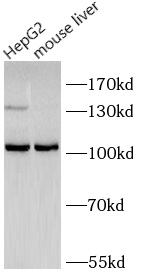产品
CLOCK antibody
- 产品介绍
- 实验结果
- 实验条件
- 常见问题
- 产品名称
- CLOCK antibody
- 货号
- FNab01769
- 规格
- 100μg
- 状态
- liquid
- 纯化方法
- Immunogen affinity purified
- 纯度
- ≥95% as determined by SDS-PAGE
- 克隆性
- polyclonal
- 亚型
- IgG
- 存储
- PBS with 0.02% sodium azide and 50% glycerol pH 7.3, -20℃ for 12 months(Avoid repeated freeze / thaw cycles.)
- 免疫原
- clock homolog(Mouse)
- 别称
- Circadian locomoter output cycles protein kaput (hCLOCK)|Class E basic helix-loop-helix protein 8 (bHLHe8)|CLOCK|BHLHE8|KIAA0334 antibody
- UniProt ID
- O15516
- 分子量
- 110 kDa
- 验证实验
- ELISA, WB, IP, IF
- 建议稀释比例
- WB: 1:500-1:2000; IP: 1:200-1:1000; IF: 1:20-1:200
 Various lysates were subjected to SDS PAGE followed by western blot with FNab01769(CLOCK antibody) at dilution of 1:500
Various lysates were subjected to SDS PAGE followed by western blot with FNab01769(CLOCK antibody) at dilution of 1:500
 IP result of anti-CLOCK(IP:FNab01769, 4ug; Detection:FNab01769 1:300) with HeLa cells lysate 1600 ug
IP result of anti-CLOCK(IP:FNab01769, 4ug; Detection:FNab01769 1:300) with HeLa cells lysate 1600 ug
- 背景介绍
- Transcriptional activator which forms a core component of the circadian clock. The circadian clock, an internal time-keeping system, regulates various physiological processes through the generation of approximately 24 hour circadian rhythms in gene expression, which are translated into rhythms in metabolism and behavior. It is derived from the Latin roots 'circa'(about) and 'diem'(day) and acts as an important regulator of a wide array of physiological functions including metabolism, sleep, body temperature, blood pressure, endocrine, immune, cardiovascular, and renal function. Consists of two major components: the central clock, residing in the suprachiasmatic nucleus(SCN) of the brain, and the peripheral clocks that are present in nearly every tissue and organ system. Both the central and peripheral clocks can be reset by environmental cues, also known as Zeitgebers(German for 'timegivers'). The predominant Zeitgeber for the central clock is light, which is sensed by retina and signals directly to the SCN. The central clock entrains the peripheral clocks through neuronal and hormonal signals, body temperature and feeding-related cues, aligning all clocks with the external light/dark cycle. Circadian rhythms allow an organism to achieve temporal homeostasis with its environment at the molecular level by regulating gene expression to create a peak of protein expression once every 24 hours to control when a particular physiological process is most active with respect to the solar day. Transcription and translation of core clock components(CLOCK, NPAS2, ARNTL/BMAL1, ARNTL2/BMAL2, PER1, PER2, PER3, CRY1 and CRY2) plays a critical role in rhythm generation, whereas delays imposed by post-translational modifications(PTMs) are important for determining the period(tau) of the rhythms(tau refers to the period of a rhythm and is the length, in time, of one complete cycle). A diurnal rhythm is synchronized with the day/night cycle, while the ultradian and infradian rhythms have a period shorter and longer than 24 hours, respectively. Disruptions in the circadian rhythms contribute to the pathology of cardiovascular diseases, cancer, metabolic syndromes and aging. A transcription/translation feedback loop(TTFL) forms the core of the molecular circadian clock mechanism. Transcription factors, CLOCK or NPAS2 and ARNTL/BMAL1 or ARNTL2/BMAL2, form the positive limb of the feedback loop, act in the form of a heterodimer and activate the transcription of core clock genes and clock-controlled genes(involved in key metabolic processes), harboring E-box elements(5'-CACGTG-3') within their promoters. The core clock genes: PER1/2/3 and CRY1/2 which are transcriptional repressors form the negative limb of the feedback loop and interact with the CLOCK|NPAS2-ARNTL/BMAL1|ARNTL2/BMAL2 heterodimer inhibiting its activity and thereby negatively regulating their own expression. This heterodimer also activates nuclear receptors NR1D1/2 and RORA/B/G, which form a second feedback loop and which activate and repress ARNTL/BMAL1 transcription, respectively. CLOCK has an intrinsic acetyltransferase activity, which enables circadian chromatin remodeling by acetylating histones and nonhistone proteins, including its own partner ARNTL/BMAL1. Regulates the circadian expression of ICAM1, VCAM1, CCL2, THPO and MPL and also acts as an enhancer of the transactivation potential of NF-kappaB. Plays an important role in the homeostatic regulation of sleep. The CLOCK-ARNTL/BMAL1 heterodimer regulates the circadian expression of SERPINE1/PAI1, VWF, B3, CCRN4L/NOC, NAMPT, DBP, MYOD1, PPARGC1A, PPARGC1B, SIRT1, GYS2, F7, NGFR, GNRHR, BHLHE40/DEC1, ATF4, MTA1, KLF10 and also genes implicated in glucose and lipid metabolism. Represses glucocorticoid receptor NR3C1/GR-induced transcriptional activity by reducing the association of NR3C1/GR to glucocorticoid response elements(GREs) via the acetylation of multiple lysine residues located in its hinge region. Promotes rhythmic chromatin opening, regulating the DNA accessibility of other transcription factors. The CLOCK-ARNTL2/BMAL2 heterodimer activates the transcription of SERPINE1/PAI1 and BHLHE40/DEC1.
抗体可以回收利用几次?
一般抗体不推荐回收利用,抗体使用之后缓冲体系已经发生改变,不同客户在回收抗体的保存条件上也会有差异,所以抗体回收使用效果无法保证。
FineTest公司也做过一批抗体回收验证测试,测试结果显示不同抗体可回收次数不同,一般效价越高的抗体,可重复使用的次数越多,客户可根据实验情况来确定。
注:我们将孵育完毕后剩余的抗体回收到离心管中置于4℃保存,效价高的抗体可至少保存1周,重复利用3次左右。
FineTest公司抗体buffer成分是什么?
FineTest抗体成分一般是PBS含proclin300或sodium azide、BSA、50%甘油;也有一些是PBS含proclin300或sodium azide,50%甘油。防腐剂proclin300或sodium azide是常用的防腐剂,广泛应用于实验室和工业中。
FineTest公司抗体的保存温度和时间?
大部分抗体是放在-20℃保存,直标流式抗体需要放在2-8℃保存,质保期一年,质保期内抗体出现售后,可进行退货或换货。
一般抗体超过一年质保期仍旧可以使用,我们可以提供技术支持服务。
FineTest公司抗体使用需要稀释吗?用什么溶液稀释?
除了直标流式抗体为即用型,不用稀释。其他抗体一般为浓缩型,使用时需要按照说明书建议稀释比例稀释。
不同实验使用的稀释液不同,用PBST, TBST, 抗体封闭液等常用抗体稀释液均可。
免疫组化实验抗体的修复方式?
常用修复液:Tris-EDTA缓冲液(Tris-EDTA Buffer, pH 9.0);柠檬酸盐缓冲液(Citrate Buffer, pH 6.0)
热修复:
方法1:沸水浴修复,将盛有修复液和玻片的烧杯置于沸水浴环境,保持外部沸腾状态15min,自然冷却至室温;
方法2:微波修复,将盛有修复液和玻片的烧杯置于微波炉中,高火5min,停火3min,中火5min,自然冷却至室温。
如何选择二抗?
(1)二抗是和一抗反应的,所以二抗必须是抗一抗宿主物种,比如一抗来源于兔,对应二抗则选择抗兔二抗,比如羊抗兔或驴抗兔。
(2)根据实验类型选择二抗偶联物,比如做ELISA, 蛋白质印迹,IHC实验,常用酶联二抗,如HRP,AP等标记。而免疫荧光实验,流式细胞术实验中,则用荧光蛋白或染料标记,比如FITC,Cy3等。














